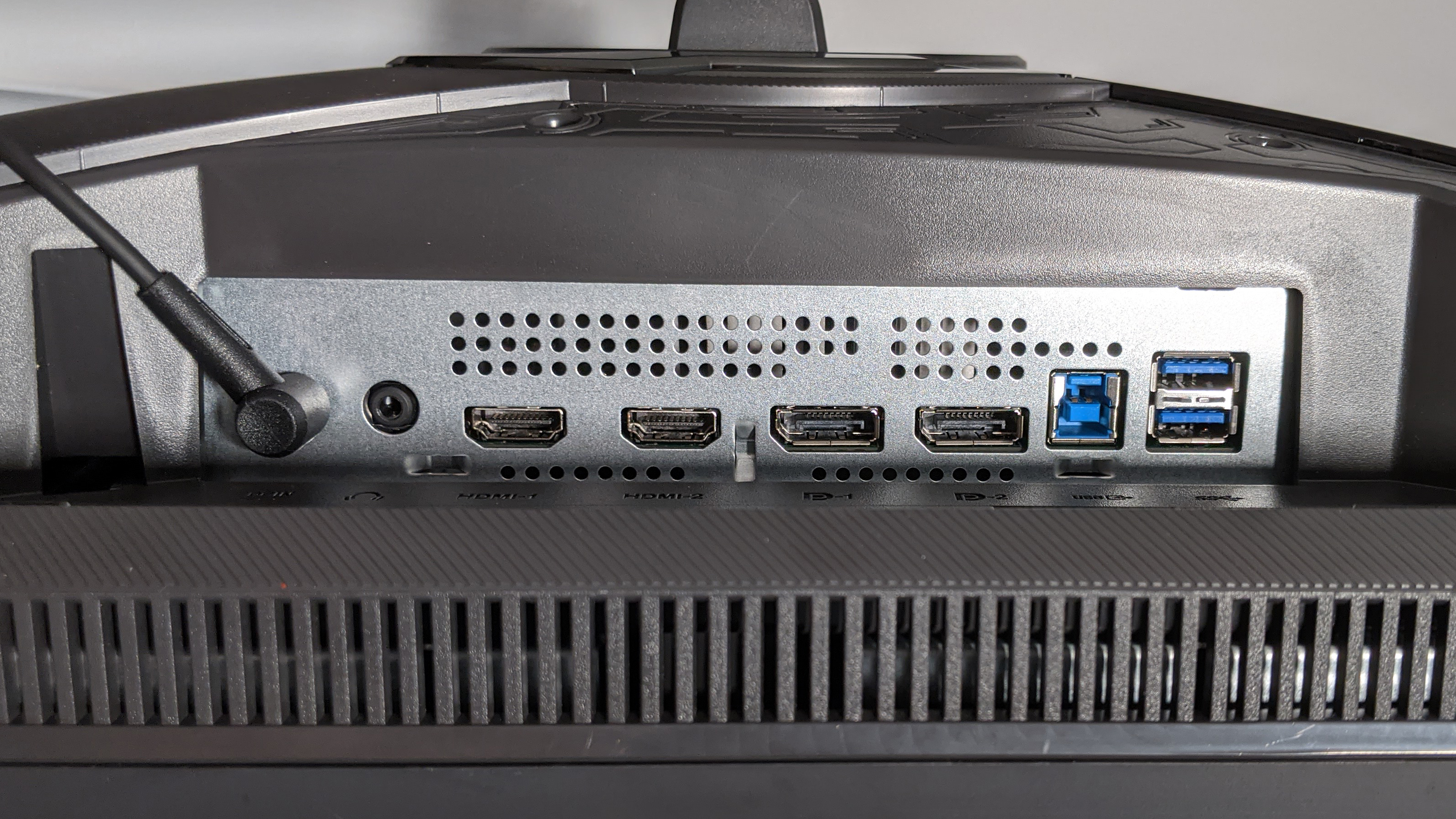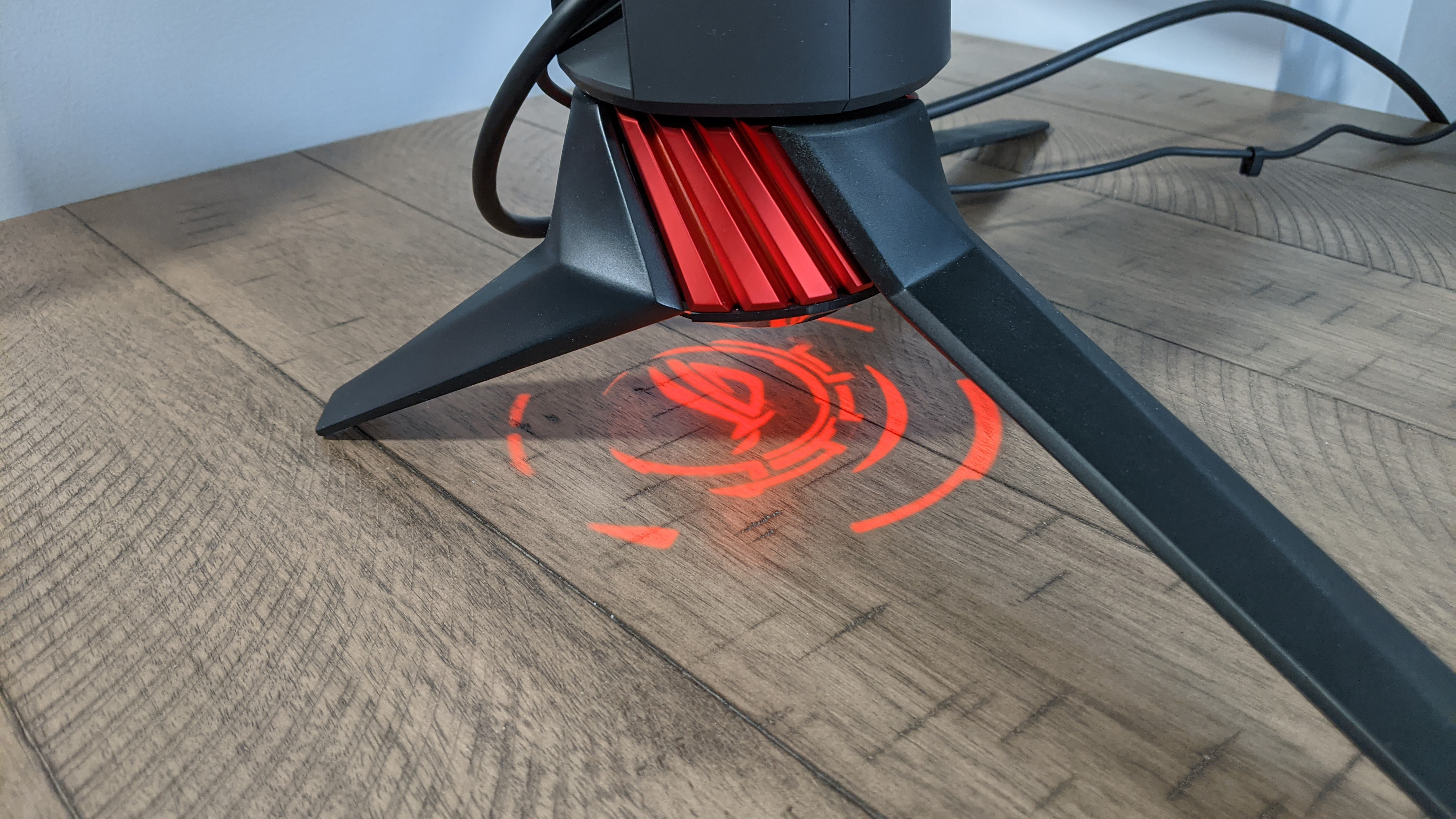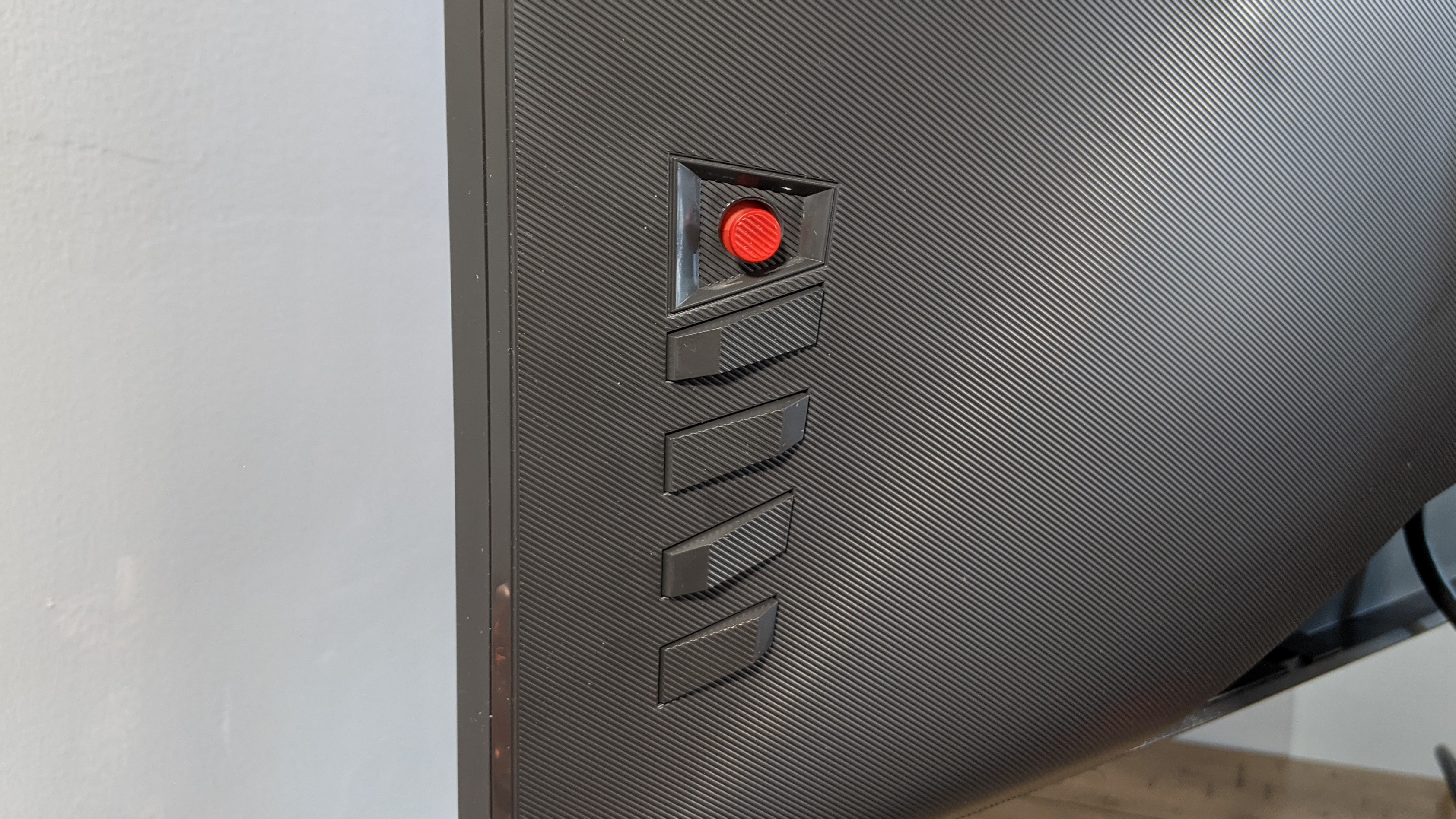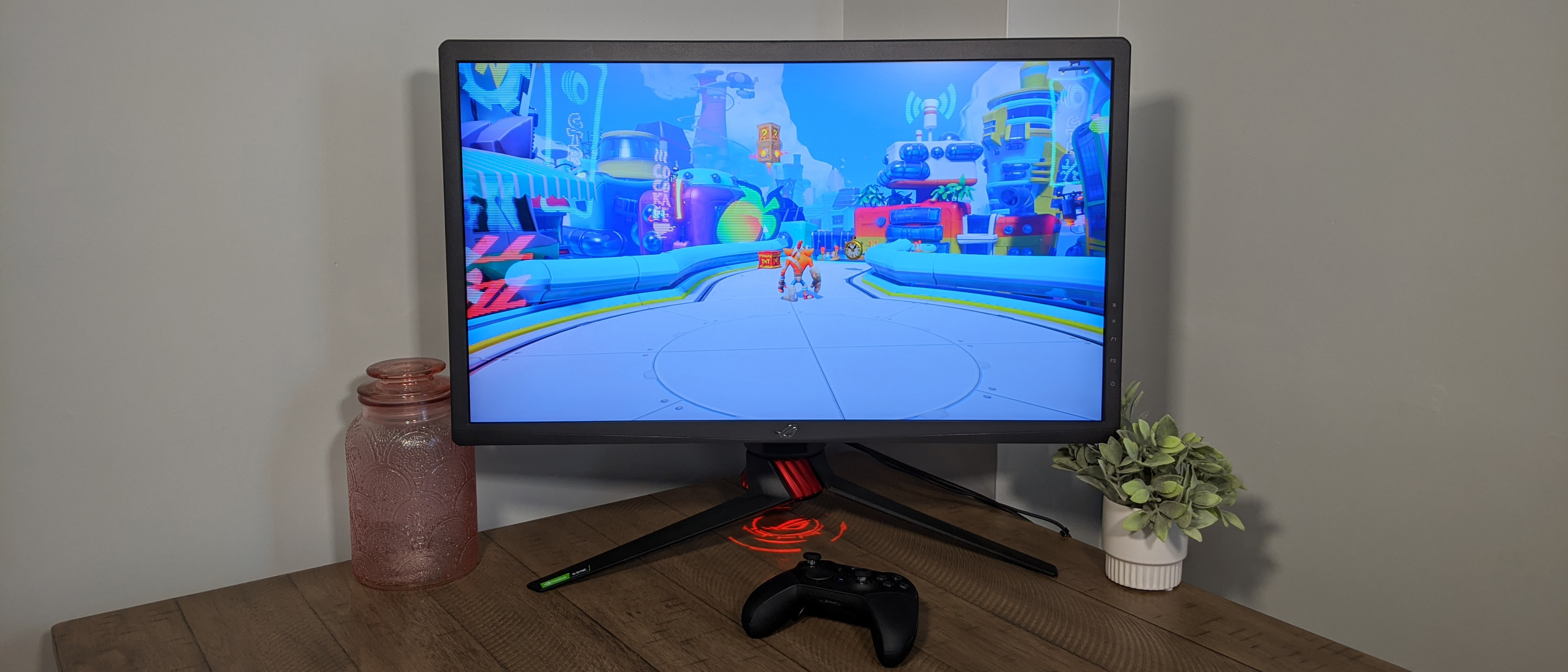Laptop Mag Verdict
The Asus ROG Strix XG27UQ offers a gorgeous 4K display with a 144Hz refresh rate and a ridiculously fast response time.
Pros
- +
Colorful and bright 4K panel
- +
144Hz refresh rate
- +
HDR400 support
- +
Fast response time
- +
Nvidia G-Sync support
Cons
- -
HDR automatically dims content
- -
No speakers
- -
Thick bezels
Why you can trust Laptop Mag
With the Xbox Series X and PS5 on their way, it’s hard not to think about what kind of monitor or TV will showcase the best of 4K or high-refresh-rate gaming, but let me introduce you to the Asus ROG Strix XG27UQ.
For $799, you get a 27-inch, 3840 x 2160-pixel display with a 144Hz refresh rate and Nvidia G-Sync support. It’s colorful and bright, HDR400-enabled, and offers a ridiculous 1-millisecond response time. However, we noticed that the HDR tends to dim content automatically, not utilizing the full potential brightness of the display. Additionally, there are no speakers, which is upsetting given the high price, and the bezels are a little thick.
Overall, if you’re looking for one of the best gaming monitors for under $1,000, the Asus ROG Strix XG27UQ is it.
Asus ROG Strix XG27UQ design
For a 27-inch monitor, the Asus ROG Strix XG27UQ makes an impression. It stood out and against a 32-inch curved monitor and another 27-inch monitor that sat on my desk. That’s all thanks to its wide, 20-inch long stand. The stand itself stands out (pun-intended), and it also pushes the display outward, making the screen more present when you look at it.
The Asus ROG Strix XG27UQ features relatively thick bezels, but each side is seemingly proportionate, so it doesn’t look bad. The bottom bezel features a glossy ROG logo while the right bezel features symbols for the controls embedded on the back.
Turning this beast around reveals a cool cyberpunk-esque design engraved in the upper half of the panel, while the lower half is home to a panel with ridges and the navigational menu buttons. On the back is a giant RGB-lit ROG logo on the right side and a smaller ROG logo on the top of the arm. The back features matte black and glossy gray pieces that blend nicely for a premium look.
The Y-shaped base is wide and measures roughly 11 inches long, but it doesn’t take up too much space since it stays behind the actual display. The base features some sleek red groves circling around it, but the highlight is the lit-up ROG projector. The only color that pops out is red, but it looks neat. You can easily turn it off in the settings if you don’t like it. Just above the base is a rectangular hole for cable management.
Sign up to receive The Snapshot, a free special dispatch from Laptop Mag, in your inbox.

The stand is capable of moving the monitor up and down by 4.7 inches, tilting goes from +20 degrees to -5 degrees. The stand also swivels 40 degrees on either side and pivots a full 90 degrees clockwise. You can absolutely use this as a vertical monitor, but it would kind of be a waste as a secondary screen. You can also hook it up a 100 x 100 millimeter VESA mount if you want to put it against a wall
At 23.6 pounds and 24.9 x 17.2~21.9 x 10.6 inches, the Asus ROG Strix XG27UQ is a bit of a thick boy for a 27-inch monitor, so make sure you have enough room on your desk before you splurge.
Asus ROG Strix XG27UQ installation and setup
While the Asus ROG Strix XG27UQ doesn’t come preassembled, it was actually a breeze putting it together. There are only two main pieces: the base and the arm. All I had to do was insert the base into the arm and keep it in place by fastening the screw into the appropriate hole, and voila.

The monitor also comes with an LED projection cover that attaches to the bottom of the stand and emits a red ROG logo. That bit was more of a pain to get into place than putting the monitor together because it was too easy to push the plastic piece through the base and misalign it.
Asus ROG Strix XG27UQ ports, cabling and interface
Like many of Asus’ kickass displays, the Asus ROG Strix XG27UQ can be set up vertically, making the ports accessible when you pivot the display 90 degrees clockwise.

The monitor features two HDMI 2.0 ports, two DisplayPorts 1.4 inputs, one USB 3.0 Type-A port, a headphone jack and a power jack. The ports can be hidden away with an included plastic panel that snaps onto the back of the monitor.
The Asus ROG Strix XG27UQ comes with a DisplayPort 1.4 cable, an HDMI 2.0 cable and a USB Type-A to USB Type-B cable.
Thanks to its joystick as well as four clearly visible buttons, the interface was simple to navigate. When I clicked the joystick, it displayed a transparent menu, detailing the monitor’s current resolution, refresh rate, display mode, input setting, RGB setting and HDR setting.
In the Gaming tab, there are settings for OD (increases the monitor’s response time), Variable Refresh Rate (this enables Nvidia G-Sync), ELMB (similar to OD but available only on higher refresh rates), GamePlus (gives you a crosshair, timer or fps counter), GameVisual (set the visual preset for your display) and Shadow Boost (makes darker tones brighter and easier to see).
In the Image tab, you can adjust the brightness, contrast, HDR settings, dynamic dimming, ASCR (Asus Smart Contrast Ratio), aspect ratio and blue light filter. Moving over to the Color tab gives you access to settings for color temperature (Cool, Normal, Warm or User Mode), gamma and saturation. The next tab over is Input Select, and then there’s the Lighting Effect tab, which lets you customize the RGB lighting on the device. The rest of the settings are for system setup (language, sound, etc.) and keying shortcuts to some of the buttons.
Asus ROG Strix XG27UQ performance
The ROG Strix XG27UQ boasts a 27-inch, 3840 x 2160-pixel display with a 144Hz refresh rate and a 1 millisecond response time.

Keep in mind that the capabilities of HDMI and DisplayPort content are different. The HDMI port at 1920 x 1080 resolution can utilize up to 120Hz, but at 4K it’s limited to 60Hz, while the DisplayPort gets full access to 4K clocked at 144Hz. For consoles like the Xbox Series X and PS5, you’ll have to decide whether you want high refresh rates or better resolution, which may be an easy choice depending on the game you’re playing. This IPS panel also comes with HDR400 support and is compatible with Nvidia G-Sync technology.
In Crash Bandicoot 4: It’s About Time, I took a tour down one of my favorite levels, Food Run, which takes place in a futuristic metropolis. The weird metal buildings bursted violently with red, blue and purple colors as I hopped my way past dangerous obstacles. I could see the sharp tiny gaps between Crash’s dumb adorable smile as I was jumping toward the screen. In another one of my favorite levels, Off Beat, I tested the darker shadows that lie in the corners of the map and, even though some sections didn’t pop as much, they were still detailed.
Crash 4 isn’t HDR capable, so I played a game that was: The Elder Scrolls Online. Firstly, let me say that the HDR color is phenomenal. When I walked down the sandy dirt path toward the Spellscar to farm my Fighter’s Guild skill, I basked in the orange-yellow sunset, and the hues looked so natural as they hit the screen and illuminated the dirt around me. When I turned off HDR and switched to my original settings, all of the color was oversaturated in comparison. However, I did encounter an issue with the HDR settings; it would automatically dim the content when enabled. I noticed this during loading screens especially where an image portrayed a bright sun. The monitor would blow out the sun and dim the panel then readjust to make everything else brighter and the sun dimmer.

I fueled up my launch thrusters in No Man’s Sky and barreled out of my frigate to be greeted by an arctic planet. The icy blue surface and white clouds trapped in the atmosphere contrasted with the subtle green and brown rings that orbited the planet. Each speck of color on screen vibrated with life — I felt like I wasn’t alone in the galaxy. When diving in underground caverns, the screen was more than bright enough to light the way and even show off the detailed edges in the rock formations. When I turned the settings way, way down (to let my GTX 1070 GPU catch a break), I got all that juicy high refresh rate action, so zipping around my ship in dog fights felt smooth.
The best settings I found that made the display shine were GameVisual: Scenery Mode, Brightness: 100, Contrast: 80, Color Temperature: Normal and Saturation: 65. I blew up the saturation a little bit because it makes the color pop more. I wouldn’t recommend messing with the saturation any more than that unless you want obnoxiously vibrant colors, which is typically what I go for, but it’s plenty vibrant as it is. If you’re playing with HDR, there’s a Gaming and Cinema mode, but you can’t change any other settings attached to them.
Asus ROG Strix XG27UQ lab testing
The Asus ROG Strix XG27UQ scored high marks on our benchmark tests. We tested the display on the default settings — GameVisual: Racing, Brightness: 100 and Contrast: 80. When testing in HDR, there are no adjustable settings, so it was set to Gaming.

The Strix XG27UQ nailed 355 nits of brightness on SDR settings, which crushed the Razer Raptor 27 (295 nits) and the ViewSonic Elite XG270 (277 nits). With HDR turned on, the Strix XG27UQ can get up to 488 nits of brightness, but our testing doesn’t calculate how the display dims real content, so you will likely get brighter content with SDR.
When I said this beast was colorful, I wasn’t exaggerating. The Strix XG27UQ covers a whopping 108% of the DCI-P3 color gamut, which is above its 90% projected rating. The Elite XG270 managed 94%, but the Raptor 27 excelled with 115%.
When it comes to sRGB, the Strix XG27UQ covered 152%, sailing past the Elite XG270 (132%) once again, but it couldn’t quite top the Raptor 27 (162%).
However, the color accuracy is still great, at a Delta-E rating of 0.28 (lower is better), which is more accurate than the Raptor 27 (0.3), but a fraction behind the Elite XG270 (0.27).
Bottom line
If you’re on the hunt for a new display for next-gen consoles or something to blow past 4K, 60Hz on PC, you’ll be hard pressed to find a better sub-$1,000 than the Asus ROG Strix XG27UQ. You get ridiculously colorful and bright visuals as well as a 144Hz refresh rate and Nvidia G-Sync technology. But the HDR can be troublesome and the lack of speakers is somewhat insulting.
You can opt for the somewhat cheaper $699 Razer Raptor 27. With this beast, you’re getting a more colorful display, clever cable management solution and an overall sleek design. However, for the price, the Raptor is trapped at a 2560 x 1400 resolution.
For just $100 more, you can be gaming at 4K, 144Hz on the Asus ROG Strix XG27UQ. Even if your GPU isn’t fully capable of running games that high, the colors will look gorgeous no matter what resolution you set it to.

Rami Tabari is the Reviews Editor for Laptop Mag. He reviews every shape and form of a laptop as well as all sorts of cool tech. You can find him sitting at his desk surrounded by a hoarder's dream of laptops, and when he navigates his way out to civilization, you can catch him watching really bad anime or playing some kind of painfully difficult game. He’s the best at every game and he just doesn’t lose. That’s why you’ll occasionally catch his byline attached to the latest Souls-like challenge.

